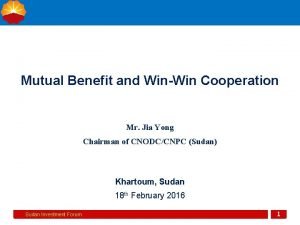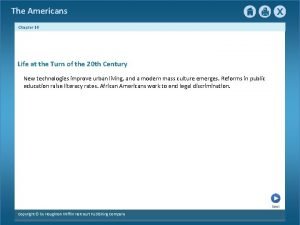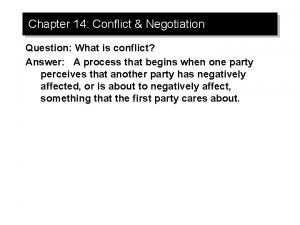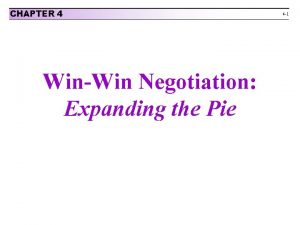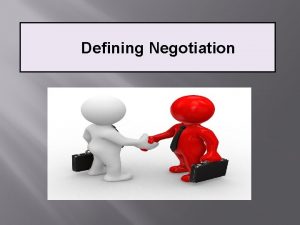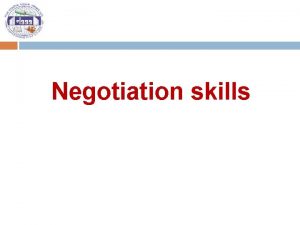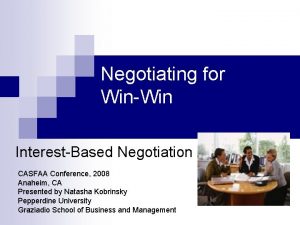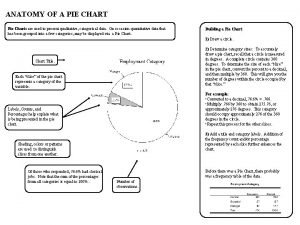WinWin Negotiation Expanding the Pie Chapter 7 Dr


















































- Slides: 50

Win-Win Negotiation: Expanding the Pie Chapter 7 Dr. Senem SÖNMEZ SELÇUK

2 Many negotiators, upon reaching agreement, will proudly describe their negotiations as win-win. However, closer inspection usually reveals that money was squandered, resources wasted, and potential joint gain untapped. Win-win negotiation is a nice idea that is too often poorly understood and poorly acted upon. Most people erroneously equate win-win negotiations to mean splitting the pie evenly. Obviously, dividing the pie is always necessary in negotiation, and people can feel emotional about it. INTF 3356 - International Sales & Negotiation Techniques

3 Faulty Perceptions of Win-Win Negotiation Win-win negotiation means something entirely different. Win-win is not: Compromise Even split Satisfaction Building a relationship INTF 3356 - International Sales & Negotiation Techniques

4 - Compromise is middle ground between negotiators' positions. Usually, it means any space within the bargaining zone. Win-win negotiation does not pertain to how the pie is divided, but rather, to how the pie is enlarged by negotiators. In several instances negotiators may make compromises, yet leave money on the table. INTF 33 3356 - International Sales & Negotiation Techniques

5 - Even splits, like compromises, refer to how the bargaining zone is divided among the negotiators. For example, two sisters who quarrel over an orange and ultimately decide to cut it in half have reached an even split. However, if they fail to realize that one sister wants all of the juice and the other wants all of the rind, it is painfully clear that the even split is not win-win. An even split of resources in no way ensures that an integrative agreement has been reached. INTF 3356 - International Sales & Negotiation Techniques

6 - Feeling good Happiness, Happiness or feeling good, good is no guarantee that money and resources have not been wasted: in fact, many "happy" negotiators do not expand the pie. INTF 3356 - International Sales & Negotiation Techniques

7 - Building a relationship and establishing trust is an important aspect of negotiation. However, it is not sufficient to proclaim a negotiation as win-win. Even people with a genuine interest in the other party may not be thinking creatively and crafting win-win deals. In fact, people who would seem to have the most interest in building a relationship with the other party (for example, husbands and wives, dating couples, and long -term partners) often fail to reach integrative agreements. INTF 33 3356 - International Sales & Negotiation Techniques

8 Win-win negotiation really means that all creative opportunities are exploited and no resources are left on the table. These outcomes are called integrative negotiations. INTF 33 3356 - International Sales & Negotiation Techniques

9 Telltale Signs of Win-Win Potential The following questions are designed to determine the possibility for win-win negotiation. They are excellent questions for negotiators to ask when assessing the potential of a negotiation situation. Does the negotiation contain more than one issue? Can other issues be brought in? Can side deals be made? Do parties have different preferences across negotiation issues? INTF 33 3356 - International Sales & Negotiation Techniques

10 - Does the negotiation contain more than one issue? Most negotiation situations present themselves as singleissue negotiations. By definition, single-issue negotiations are not win-win because whatever one party gains, the other party loses. However, even in the simplest of negotiations, it is possible to identify more than one issue. The probability that negotiators will have identical preferences across all issues is small, and it is differences in preferences, beliefs, and capacities that may be profitably traded off to create joint gain.

11 - Can other issues be brought in? Another strategy is to bring other issues not previously considered into the negotiation. The more moving parts, the better is the potential deal. INTF 3356 - International Sales & Negotiation Techniques

12 - Can side deals be made? In many situations, people are strictly cautioned not to make side deals or side payments. In contrast, the ability to bring other people into negotiations to make side deals may increase the size of the bargaining pie. INTF 3356 - International Sales & Negotiation Techniques

13 - Do parties have different preferences across negotiation issues? If parties have different strengths of preference across the negotiation issues, by definition, it is a win-win negotiation. If only a single issue was involved or if both partys had the same preferences, then an integrative agreement would not be possible. The key is to determine each party's preferences and devise a means of satisfying each party's most important interests while inducing them to make concessions on lower-priority issues.

14 A Pyramid Model True win-win or integrative negotiations leave no resources underutilized. We distinguish three "levels" of integrative, or win-win. agreements. The pyramid model presented in Figure depicts the three levels of integrative agreements. Beginning at the base, each successive level subsumes the properties of the levels below it. Ideally, negotiators should always strive to reach level 3 integrative agreements. Higher levels are progressively more difficult for negotiators to achieve, but they are more beneficial to negotiators.

15 Level 3: Paretooptimal Level 2: Settlement demonstrably superior to other feasible settlements Level 1: Mutual settlement (positive bargaining zone) Exhibit 4 -1: A Pyramid Model of Integrative Agreements

16 Level 1 integrative agreements exceed parties' noagreement possibilities, or reservation points. Reaching an agreement that exceeds parties' noagreement possibilities creates value relative to their best alternative. Negotiators create value by reaching settlements that are better than their reservation points, or disagreement alternatives. INTF 33 3356 - International Sales & Negotiation Techniques

17 Level 2 integrative agreements are better for both parties than are other feasible negotiated agreements. In other words, negotiators create value with respect to one negotiated outcome by finding another outcome that all prefer. The existence of such agreements, by definition, implies that the bargaining situation is not purely fixed-sum: Some agreements yield higher joint gain than do others. INTF 33 3356 - International Sales & Negotiation Techniques

18 By definition, in purely fixed-sum situations, situations all outcomes sum to the same joint amount, and, therefore, no alternative agreement exists that improves one party's outcome while simultaneously improving or not reducing the outcome of the other party. If negotiators fail to reach agreement in a fixed-sum negotiation when the bargaining zone is positive, they have failed to reach a level 1 agreement. Unlike the pure fixed-sum case, integrativeness is much more difficult to assess in the more common mixedmotive case. INTF 33 3356 - International Sales & Negotiation Techniques

19 Level 3 integrative agreements are impossible to improve upon from the perspective of both parties. Technically speaking, level 3 integrative agreements are settlements that lie along the Pareto-optimal frontier of agreement, meaning that no other feasible agreement exists that would improve one party's outcome while simultaneously not hurting the other party's outcome. Therefore, any agreement reached by negotiators in a purely fixed-sum situation is level 3, leaving no way to improve any negotiator's outcome without making the other party worse off. INTF 33 3356 - International Sales & Negotiation Techniques

20 Most Common Pie-Expanding Errors If reaching win-win negotiation agreements is the objective of most negotiators, what prevents them from doing so? Negotiators encounter two key problems; False conflict Fixed-pie perception INTF 33 3356 - International Sales & Negotiation Techniques

21 - False Conflict False conflict, conflict also known as illusory conflict, conflict occurs when people believe that their interests are incompatible with the other party's interests when, in fact, they are not. In 1990, Thompson and Hastie uncovered a particularly insidious and widespread effect in negotiations: the lose effect, a situation in which people fail to capitalize on compatible interests. They constructed a negotiation situation in which the parties involved had compatible interests on a subset of the negotiation issues, meaning both parties wanted the same outcome.

22 What should negotiators do to avoid lose-lose agreements? 1) First, negotiators should be aware of the fixed-pie perception and not automatically assume that their interests are opposed by the other party. 2) Second, negotiators should avoid making premature concessions to the other party (i. e. , giving up ground on issues before even being asked). 3) Finally, negotiators should develop an accurate understanding of the other party's interests —a skill we will explore soon. INTF 3356 - International Sales & Negotiation Techniques

23 - Fixed-Pie Perception The fixed-pie perception is the belief that the other party's interests are directly and completely opposed to one's own interests. Most untrained negotiators view negotiation as a pieslicing task: They assume that their interests are incompatible, that impasse is likely, and that issues are settled one by one rather than as packages. In short, negotiators with fixed-pie perceptions literally throw money away. INTF 33 3356 - International Sales & Negotiation Techniques

24 Expanding the Pie: Strategies That Do Not Work Commitment to reaching a win-win deal Compromise Focusing on a long-term relationship Adopting a “cooperative orientation” Taking extra time to negotiate INTF 33 3356 - International Sales & Negotiation Techniques

25 - Commitment to reaching a win-win deal Many negotiators approach the negotiation table committed to reaching a win-win deal. However, commitment to reaching a win-win deal does not guarantee that negotiators will reach a win-win agreement, primarily because they are working with an incorrect idea about what win-win is. In fact, it may lull them into a false sense of security. INTF 33 3356 - International Sales & Negotiation Techniques

26 - Compromise Negotiators often mistake win-win negotiations for equal -concession negotiations. Equal concessions or "splitting the difference" does not really ensure that a win-win negotiation has been reached. Compromise pertains to slicing the pie, not expanding the pie. INTF 33 3356 - International Sales & Negotiation Techniques

27 - Focusing on a Long-Term Relationship Oftentimes, negotiators believe that focusing on the longterm nature of their relationship with the other party will ensure a win-win deal. Obviously, the long-term relationship is key in negotiation, but, establishing a long-term relationship does not translate directly into win-win. Rather, it means that negotiators should have an easier time working to reach win-win. It is a nice intention, but it does not guarantee that all the resources will be discovered and optimally exploited in the negotiation.

28 - Adopting a Cooperative Orientation It is nice when negotiators approach the negotiation table with benevolent attitudes and a cooperative orientation. However, negotiators' intentions to cooperate often keep them from focusing on the right information at the right time. For example, negotiators often attempt to cooperate by revealing their BATNA to the other party: revealing one's BATNA is a pie-slicing issue, not a pie-expanding issue. Negotiators often think cooperation means compromise, and compromises often mean lose-lose negotiation.

29 - Taking Extra Time to Negotiate Negotiators often think that, with a little extra time, they can achieve all the joint gains possible in a negotiation. Extra time does not guarantee that negotiators will reach an integrative agreement agreemen (most negotiators wait until the last few moments of a negotiation to reach an agreement), and the quality of the negotiation does not improve with additional time. More time to negotiate does not improve the quality of negotiated agreements. INTF 33 3356 - International Sales & Negotiation Techniques

30 Expanding the Pie: Strategies That Work There are nine strategies that can help negotiators expand the pie and create win-win negotiations. We ordered them in terms of the most obvious and intuitive strategies —the ones that your grandmother probably could have told you about— to strategies that are more sophisticated. The first few strategies are especially good to use when negotiating with someone who seems cooperative and trustworthy; the strategies that come later on this list are useful when dealing with "problem people" or extremely tough negotiators

31 Expanding the Pie: Strategies That Work (I) Perspective-taking Ask questions about interests and priorities Provide information about your interests and priorities Unbundle the issues Make package deals, not single-issue offers Make multiple offers of equivalent value simultaneously INTF 33 3356 - International Sales & Negotiation Techniques

32 Expanding the Pie: Strategies That Work (II) Structure contingency contracts by capitalizing on differences Valuation Expectations Risk attitudes Time preferences Capabilities Cautionary note on effective contingency contracts Presettlements (Pre. SS) Postsettlements INTF 33 3356 - International Sales & Negotiation Techniques

33 - Build Trust and Share Information Negotiators who build a trusting relationship and share information greatly increase the probability that a winwin outcome will be reached. It is important to realize that the information that negotiators need to share is not information about their BATNAs, but rather, information about their preferences and priorities across the negotiation issues. INTF 33 3356 - International Sales & Negotiation Techniques

34 Negotiators can exchange six key types of information during negotiation. These are; BATNA and reservation price, price position (stated demand), demand underlying interests, interests priorities, priorities key facts and substantiation). substantiation The skilled negotiator knows how to recognize each. Even more important, the skilled negotiator knows what information is safe (and even necessary) to reveal in order to reach win-win outcomes. INTF 3356 - International Sales & Negotiation Techniques

35 Exhibit 7 -1: Types of Information in Negotiation and How Each Affects Distributive and Integrative Agreements Type of Information Definition (example) Claiming Value Creating Value BATNA (and reservation price) The alternatives a negotiator has outside of the current negotiation (e. g. , “If I don’t buy your car, I can buy my uncle’s car for $2, 000”) Revealing this information severely hurts ability to maximize negotiator surplus Revealing or obtaining this information does not affect ability to reach level 2 or 3 integrative agreements; might help negotiators reach level 1 integrative agreements Position (stated demand) Usually, a negotiator’s opening offer; the behavioral manifestation of his/her target point (e. g. , “I will give you $1, 500 for your car”) Opening with an aggressive target point significantly increases the negotiator’s surplus (share of the bargaining zone) Does not affect integrative agreements Underlying interests The underlying needs and reasons a negotiator has for a particular issue (e. g. , “I need a car because I need transportation to my job site, which is 15 miles away in a rural zone”) Revealing this information generally increases likelihood of obtaining a favorable slice of the pie because negotiators who provide a rationale for their demands are more adept at realizing their targets Very important for reaching win-win deals; by (truthfully) revealing underlying interests, negotiators can discover win-win agreements (e. g. , one sister tells the other that she wants the orange because she needs to make juice and has no need for rinds) Priorities A judgment about the relative importance of the issues to a negotiator (e. g. , “I am more concerned about the down payment than I am about the financing for the car”) Increases a negotiator’s surplus indirectly, because if more value is created via sharing priorities, then the probability that a negotiator will get a larger slice of the pie increases Vitally important for maximizing the pie (e. g. , the sister who said she cared more about the rinds relative to the juice created potential for integrative agreement) Key facts Pertains to information that bears on the quality and the value of the to-be-negotiated issues (e. g. , “The car has a rebuilt engine and has been involved in a major collision; ” “The oranges are genetically modified”) This information can affect the slice of the pie the negotiator obtains in that facts either increase or decrease the value of the to-be-negotiated issues Affects the quality of win-win agreements in that failure to reveal key information may lead a negotiator to over- or undervalue a particular resource (e. g. , someone who sells “fresh organic orange juice” does not want to have genetically-modified oranges as an ingredient) Substantiation Argument either made to support one’s own position or to attack the other party’s position (e. g. , “You will get lots of dates if you buy my car because women like it”) Most dominant type of distributive tactic (24% to 27% of all statements); ** can increase a negotiator’s slice of the pie because providing a rationale (even an absurd one) can often be effective in obtaining a demand A distributive tactic; does not increase win-win negotiation and may, in fact, reduce likelihood of win-win*

36 - Ask Diagnostic Questions A negotiator could ask the other party in a negotiation any number of questions However, of the six types of information listed in Table 41, only two are truly directly helpful types of questions to ask in terms of expanding the pie — questions about underlying interests and questions about priorities. A negotiator who asks the other party about his or her preferences is much more likely to reach an integrative agreement than a negotiator who does not ask the other party about his or her priorities. INTF 33 3356 - International Sales & Negotiation Techniques

37 - Provide Information It is a fallacy to believe that negotiators should never provide information to their opponent. Negotiations would not go anywhere if negotiators did not communicate their interests to the other party. Remember, you should negotiate as you would with your fraternal twin: If you do not provide information, neither will the other party. A negotiator should never ask the other party a question that he or she is not willing to answer truthfully. The important question, then, is not whether to reveal information, but what information to reveal. INTF 33 3356 - International Sales & Negotiation Techniques

38 Adair and her colleague divided the negotiation into four quarters. They found that; 1) During the first quarter, people are more likely to use influence strategies as they battle for power and influence. 2) During the second quarter, priority information peaks as negotiators began to discuss the issues and share information about their priorities. 3) In the third quarter, negotiators often engage in a dance of making offers and counteroffers and either support or reject them on the basis of rational argument. 4) In the fourth quarter, negotiators begin to work toward agreement by building on each other's offers.

39 - Unbundle the Issues One reason negotiations fail is because negotiators haggle over a single issue, such as price. By definition, if negotiations contain only one issue (e. g. . price), they are purely distributive (i. e. , fixed-pie). Skilled negotiators are adept at expanding the set of negotiable issues. Adding issues, unbundling issues, and creating new issues can transform a single-issue, fixed-pie negotiation into an integrative, multi-issue negotiation with win-win potential.

40 - Make Package Deals, Not Single-Issue Offers Most negotiators make the mistake of negotiating each issue one by one. This approach is a mistake for several reasons: 1) First and foremost, negotiating each issue separately does not allow negotiators to make trade-offs between issues. To capitalize on different strengths of preference, negotiators need to compare and contrast issues and trade them off. 2) Second, it may mean that impasse is more likely, especially if the bargaining zone is narrow and trade-offs are necessary to reach a mutually profitable outcome. 3) Finally, single-issue offers lure negotiators into compromise agreements, which are usually not the best approach for win-win negotiations.

41 - Make Multiple Offers Simultaneously The strategy of multiple simultaneous offers can be effective even with the most uncooperative of negotiators. The strategy involves presenting the other party with at least two (and preferably more) proposals of equal value to oneself. Negotiators who make multiple equivalent offers enjoy more profitable negotiated outcomes and are evaluated more favorably by the other party. Specifically, they are seen as being more flexible by the other side. And, they are more satisfied at the end of the negotiation.

42 The multiple-offer strategy is threefold: 1) Devise multiple-issue offers, as opposed to singleissue offers (to get away from sequential bargaining, which can lock people into lose-lose outcomes). 2) Devise offers that are all of equal value to yourself (leaving yourself many ways to get what you want before making a concession). 3) Make the offers all at the same time (In the multipleoffer strategy, a negotiator presents a "dessert tray" of offers to the other party and invites a reaction. INTF 33 3356 - International Sales & Negotiation Techniques

43 According to Medvec and Galinsky, the negotiator who makes multiple, equivalent offers has an edge in five critical aspects: They can, 1) be more aggressive in terms of anchoring the negotiation favorably. 2) gain better information about the other party. 3) be more persistent. 4) signal their priorities more effectively, and 5) overcome concession aversion on the part of the other side. INTF 3356 - International Sales & Negotiation Techniques

44 - Structure Contingency Contracts by Capitalizing on Differences The surprising fact is that differences in beliefs —or expectations about uncertain events— pave the way toward integrative agreements. Given these differing predictions, it is somewhat ironic to think that they might be leveraged to create a workable solution. In fact, it is differences, rather than commonalities, that can be more advantageous in negotiations. The enlightened negotiator realizes that differences in beliefs, expectations, and tastes can create greater value than when both negotiators have identical preferences.

45 Negotiators can exploit differences to capitalize on integrative agreements in a variety of ways. Consider the following differences and the opportunities they create: Differences in the valuation of the negotiation issues Differences in expectations of uncertain events Differences in risk attitudes Differences in time preferences Differences in capabilities INTF 33 3356 - International Sales & Negotiation Techniques

46 - Presettlement Settlements (Pre. SS) Presettlements (Pre. SS), have three characteristics: They are formal, formal in that they encompass specific, binding obligations, initial, initial because they are intended to be replaced by a formal agreement, agreement and partial, partial in that the parties do not address or resolve all outstanding issues. INTF 33 3356 - International Sales & Negotiation Techniques

47 Pre. SSs involve more than a simple handshake or "gentleman's agreement". Rather, a Pre. SS occurs in advance of the parties undertaking full-scale negotiations and is designed to be replaced by a longterm agreement. A Pre. SS resolves only a subset of the issues on which the parties disagree (i. e. . partial). In some cases, instead of resolving any of the outstanding issues, a Pre. SS may simply establish a concrete framework for final negotiations. INTF 33 3356 - International Sales & Negotiation Techniques

48 - Search for Postsettlement Settlements A final strategy for expanding the pie is one in which negotiators reach an initial settlement that both agree to but spend additional time attempting to improve upon (each from their own perspective). In the postsettlement strategy, strategy negotiators agree to explore other options with the goal of finding another that both prefer more than the current one or that one party prefers more and the other is indifferent to. INTF 33 3356 - International Sales & Negotiation Techniques

49 The current settlement becomes both parties' new BATNA. For anyfuture agreement to replace the current one, both parties must be in agreement: otherwise, they revert to the initial agreement. The postsettlement strategy allows both parties to reveal their preferences without fear of exploitation, exploitation because they can safely revert to their previous agreement. If better terms are found, parties can be more confident they have reached a level 2 or 3 settlement. INTF 33 3356 - International Sales & Negotiation Techniques

50 not acceptable (optimistic) not acceptable (bleak) Resource Assessment of Differences Construct Offers and Trade-Offs Current “Best” Terms Impasse both agree Postsettlement Settlements Implement Agreement Exhibit 7 -2: Decision-Making Model of Integrative Negotiation
 Expanding the pie negotiation example
Expanding the pie negotiation example Contoh pie chart
Contoh pie chart Covey win win
Covey win win Win win situation examples
Win win situation examples Winwin south sudan
Winwin south sudan Win lose attitude
Win lose attitude Chapter 9 expanding markets and moving west
Chapter 9 expanding markets and moving west Chapter 16 section 2 expanding public education
Chapter 16 section 2 expanding public education Chapter 9 expanding markets and moving west
Chapter 9 expanding markets and moving west Chapter 9 expanding markets and moving west
Chapter 9 expanding markets and moving west Chapter 14 conflict and negotiation
Chapter 14 conflict and negotiation Pie chart the great gatsby chapter 9 blame chart answers
Pie chart the great gatsby chapter 9 blame chart answers Hình ảnh bộ gõ cơ thể búng tay
Hình ảnh bộ gõ cơ thể búng tay Frameset trong html5
Frameset trong html5 Bổ thể
Bổ thể Tỉ lệ cơ thể trẻ em
Tỉ lệ cơ thể trẻ em Chó sói
Chó sói Tư thế worm breton là gì
Tư thế worm breton là gì Chúa yêu trần thế
Chúa yêu trần thế Kể tên các môn thể thao
Kể tên các môn thể thao Thế nào là hệ số cao nhất
Thế nào là hệ số cao nhất Các châu lục và đại dương trên thế giới
Các châu lục và đại dương trên thế giới Công thức tiính động năng
Công thức tiính động năng Trời xanh đây là của chúng ta thể thơ
Trời xanh đây là của chúng ta thể thơ Cách giải mật thư tọa độ
Cách giải mật thư tọa độ 101012 bằng
101012 bằng độ dài liên kết
độ dài liên kết Các châu lục và đại dương trên thế giới
Các châu lục và đại dương trên thế giới Thể thơ truyền thống
Thể thơ truyền thống Quá trình desamine hóa có thể tạo ra
Quá trình desamine hóa có thể tạo ra Một số thể thơ truyền thống
Một số thể thơ truyền thống Cái miệng bé xinh thế chỉ nói điều hay thôi
Cái miệng bé xinh thế chỉ nói điều hay thôi Vẽ hình chiếu vuông góc của vật thể sau
Vẽ hình chiếu vuông góc của vật thể sau Biện pháp chống mỏi cơ
Biện pháp chống mỏi cơ đặc điểm cơ thể của người tối cổ
đặc điểm cơ thể của người tối cổ V cc
V cc Vẽ hình chiếu đứng bằng cạnh của vật thể
Vẽ hình chiếu đứng bằng cạnh của vật thể Fecboak
Fecboak Thẻ vin
Thẻ vin đại từ thay thế
đại từ thay thế điện thế nghỉ
điện thế nghỉ Tư thế ngồi viết
Tư thế ngồi viết Diễn thế sinh thái là
Diễn thế sinh thái là Các loại đột biến cấu trúc nhiễm sắc thể
Các loại đột biến cấu trúc nhiễm sắc thể Bảng số nguyên tố
Bảng số nguyên tố Tư thế ngồi viết
Tư thế ngồi viết Lời thề hippocrates
Lời thề hippocrates Thiếu nhi thế giới liên hoan
Thiếu nhi thế giới liên hoan ưu thế lai là gì
ưu thế lai là gì Hổ đẻ mỗi lứa mấy con
Hổ đẻ mỗi lứa mấy con Sự nuôi và dạy con của hổ
Sự nuôi và dạy con của hổ




